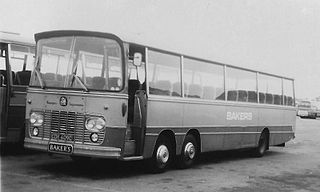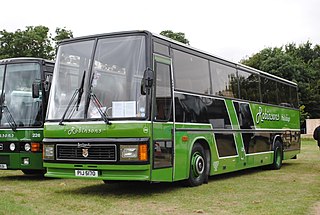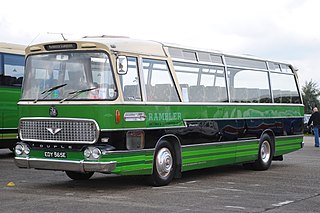
The Ford Anglia is a small family car that was designed and manufactured by Ford UK. It is related to the Ford Prefect and the later Ford Popular. The Anglia name was applied to various models between 1939 and 1967. In total, 1,594,486 Anglias were produced. It was replaced by the Ford Escort.
Plaxton is an English builder of bus and coach vehicle bodies based in Eastfield, Scarborough, England. Founded in 1907 by Frederick William Plaxton, it became a subsidiary of Alexander Dennis in May 2007. In 2019, the maker was acquired by Canadian bus manufacturer New Flyer which then became NFI Group.

The Cadillac Series 70 is a full-size V8-powered series of cars that were produced by Cadillac from the 1930s to the 1980s. It replaced the 1935 355E as the company's mainstream car just as the much less expensive Series 60 was introduced. The Series 72 and 67 were similar to the Series 75 but the 72 and 67 were produced on a slightly shorter and longer wheelbase respectively. The Series 72 was only produced in 1940 and the Series 67 was only produced in 1941 and 1942. For much of the postwar era, it was the top-of-the-line Cadillac, and was Cadillac's factory-built limousine offering.

Seddon Atkinson Vehicles Limited, was a manufacturer of large goods vehicles based in Oldham, Greater Manchester, England, was formed after the acquisition in 1970 of Atkinson Vehicles Limited of Preston by Seddon Diesel Vehicles Limited of Oldham. In 1974, the firm was acquired by International Harvester, which sold it in March 1984 to the Spanish group Enasa which made it a subsidiary of Pegaso. In 1990, it became part of Iveco which used the brand for various types of specialised vehicles in the United Kingdom. The range of models produced included EuroMover, Pacer and Strato, which are aimed at refuse collection, recycling and construction operators.

Duple Coachbuilders was a coach and bus bodybuilder in England from 1919 until 1989.

The Land Rover Tangi is a type of armoured vehicle, based on the Land Rover chassis and used in policing in Northern Ireland. They were used by the Royal Ulster Constabulary (RUC) and are currently used by its replacement, the Police Service of Northern Ireland (PSNI). The vehicle was designed and built in house by the Royal Ulster Constabulary's own engineers.

The Plaxton Supreme was a design of coach bodywork built by Plaxton. It was first built, on small chassis only, in 1974, replacing the Plaxton Panorama. On full-sized chassis, it replaced the Panorama Elite in 1975, and was superseded by the Paramount in 1982/3. However, the Supreme continued to be built on the small Bedford VAS chassis until 1986.

The Plaxton Paramount was a design of coach bodywork built by Plaxton. It first appeared at the 1982 British Motor Show and was built until 1992.

The Plaxton Premiere, Plaxton Excalibur and Plaxton Prima were closely related designs of coach bodywork built by Plaxton.

The Harrington Legionnaire is an 11 metres (36 ft) passenger coach body built by Thomas Harrington Ltd in Hove, Sussex between 1963 and 1965. It was built on three-axle Bedford VAL, two-axle Ford Thames 676E, and two specials on Guy Victory tram bus chassis.

The Plaxton Verde was a step-entrance full-size single-decker bus body built by Plaxton between 1991 and 1997. It was built on a rear-engined chassis, the most popular of which was the Dennis Lance which accounted for over half of the Verdes built. The rest were on Volvo B10B, DAF SB220 and Scania N113 chassis.

The Duple Dominant was a design of a coach bodywork built by Duple between 1972 and 1987. It introduced an all-steel structure and replaced the wooden-framed Duple Vega, Viceroy and Vista models.

The East Lancs Greenway, or National Greenway, is a type of bus which is rebuilt by East Lancashire Coachbuilders from a Leyland National single-deck bus.

Thomas Harrington & Sons was a coachbuilder in the county of Sussex from 1897 until 1966, initially at Brighton but from 1930 until the end in a purpose built Art Deco factory in Old Shoreham Road, Hove.

The Cadillac Series 355 was a V8-powered luxury car manufactured by Cadillac from 1931 until 1935. It was offered as a 2-door club coupe, 2-door convertible, 4-door convertible, 4-door sedan, 4-door town car, and 4-door limousine. It provided a range of Cadillac below the maker's larger V-12 and V-16 lines. It was succeeded by the Cadillac Series 70/75.
H. V. Burlingham was a British coachbuilding business based in Blackpool, Lancashire from 1928 until 1960 when they were taken over by London-based rivals Duple Motor Bodies. Duple initially renamed Burlingham as Duple (Northern) but in 1969 they closed their Hendon factory and concentrated production in Blackpool. Duple coach bodies were built in the former Burlingham premises until Duple itself was liquidated in 1989.

The Bristol LH was a single-decker bus chassis built by Bristol Commercial Vehicles (BCV) in Bristol, England. Nearly 2,000 were built between 1967 and 1982 in a variety of sizes and body types, including some as goods vehicles.

The Docker Daimlers were cars built for display at the British International Motor Show at Earls Court Exhibition Centre from 1951 to 1955. The cars were built on Daimler chassis by Hooper, a Daimler subsidiary, on the order of Sir Bernard Docker, chairman of Daimler and managing director of parent company Birmingham Small Arms Company (BSA), and his second wife, Lady Docker, who had been made a director of Hooper by Sir Bernard.

The Duple Caribbean was design of a coach bodywork built by Duple between 1983 and 1986. It replaced the high-floor Goldliner variant of the long-running Duple Dominant range as Duple's premium coach body of the mid 1980s.

The Duple Viceroy was a type of coach bodywork built by Duple between 1966 and 1972. It was initially launched on lightweight front-engined chassis, but it was latterly built on mid-engined and heavyweight chassis as well. A variant of the Viceroy was the Duple Viceroy Express, which had a bus-type entrance door making it suitable for stage carriage work.























